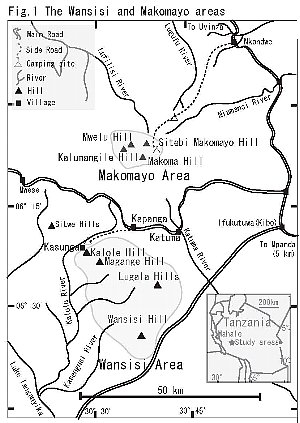|
Report on the Chimpanzees of the Wansisi and Makomayo Areas, Tanzania.
Hideshi Ogawa¹, Jim Moore², Masaomi Kanamori, and Shadrack Kamenya³ ²University of California, San Diego ³Gombe Stream Research Centre After Kano's survey on the distribution of chimpanzees (Pan troglodytes) in Tanzania between 1965 and 1967¹, the chimpanzee population in the Wansisi area has not been studied and their current status is unknown. Ogawa and Kanamori made a brief survey in the Wansisi area in Aug. 2001. Moore and Kamenya visited the Makomayo area in July 2001. Study site and period The Wansisi area is located approximately 30km west of Mpanda and 80km east of Mahale (Fig.1). This area is approximately 500km² surrounded by Kapanga village on the north (6°19'S), Maganje (Mgange) Mts. on the west (30°27'E), Wansisi Mts. on the south (6°38'S), and Lugala Mts. on the east (30°43'E)¹. The majority of this area is "miombo" woodlands dominated by Brachystegia and Julbernardia, with bamboo thickets and cultivated fields in the plains and grasslands along the Kalulu River (1,200m elevation). On Aug. 3, 2001, Ogawa and Kanamori left Mpanda, passed Katuma village, turned left at Kapanga (6°19'S, 30°37'E) out of Mpanda-Mwese road, and visited Kasunga village (6°21'S, 30°29'E). We walked a total of 30.8km (rounded-trip) at Mgange Hill (6°23' S, 30°32'E) (1,753km) and Kalole Hill (6°22'S, 30°30'E) on Aug. 4 and 5.
"Makomayo" as used here refers to the region near a series of peaks (Makoma, Sitebi Makomayo, Mwelu and Kalumangile) located about 25km NNE of Katuma village. All exceed 1,950m elevation (above the tree line) (Fig.1). The slope northward is gentle, but the mountains fall steeply in other directions where they are deeply cut by valleys containing permanent water and riverine forest; ridges are covered with short grasses, herbs, some Protea and at exposed locations, bare rocky earth. This network of highaltitude riverine forest is spread over an area of roughly 100km². Below tree line, the surrounding forest is miombo woodland broadly similar to that of Wansisi, with large stands of Uapaca in places. Moore and Kamenya camped at the Lufilisi River about 12km north of Sitebi Makomayo Hill from July 23-26, searching for chimpanzees near 6°07'S, 30°39'E and 5°58'S, 30°42'E.
Feces of chimpanzees contained seeds of Ficus sp., Grewia mollis, Azanza garkeana, Pterocarpus tinctorius, and Pseudospondias microcarpa, leaves of Monocotyledoneae, and fragments of adult ants (Formicidae). We also found 3 wadges of bamboo shoots. Bed groups, in which nests of the same age were located in the same place, averaged 5.2 beds (range: 2-9, n=15). Fresh nest leaves indicated that two recent sleeping parties were composed of 5 and 8 individuals. Although there were few evergreen forests on the hills, some deciduous trees had leaves in this period. Chimpanzees made beds on such deciduous trees of Brachystegia bussei, B. boehmii, Julbernardia paniculata, and Isoberlinia angolensis. We saw claw-marks of a carnivore like a leopard (Panthera pardus) on the trunk of a nest tree, and diarrhea feces of the chimpanzee were under that bed. The population density was roughly estimated at 0.06 individuals/km² based on 20 beds within 70m of each side of our 19.2km walking route on the hills, assuming a bed disappears in 180 days and 70% of beds in the range are found (after Kano¹). This indicates that about 30 chimpanzees inhabit the 500km² area.
During the survey, we heard vocalizations of yellow baboons (Papio cynocephalus) and a bushbuck (Tragelaphus scriptus), and saw traces from elephant (Loxodonta africana), zebra (Equus burchellii), and bushpig (Potamochoerus porcus).
A number of other primates were encountered. Most notably, there were red colobus (Colobus badius) even in a small (c. 1km²) evergreen pocket at about 1,900m (to reach other forest would require crossing at least 500m of short grass and exposed rocky soil). This group had at least 2 adult males; and over 25 individuals were observed, none with ventral infants. Yellow baboons and blue monkeys (Cercopithecus mitis) were seen and heard daily. No galagos (Galago spp.) called at night, and one glimpsed monkey at lower altitude may have been a redtail (Cercopithecus ascanius). There were indirect signs of elephant (possibly years old), zebra, bushpig, hyena (Crocuta crocuta), leopard, and civet (Viverra civetta), and several duiker (unidentified) were glimpsed.
Back to Contents |
